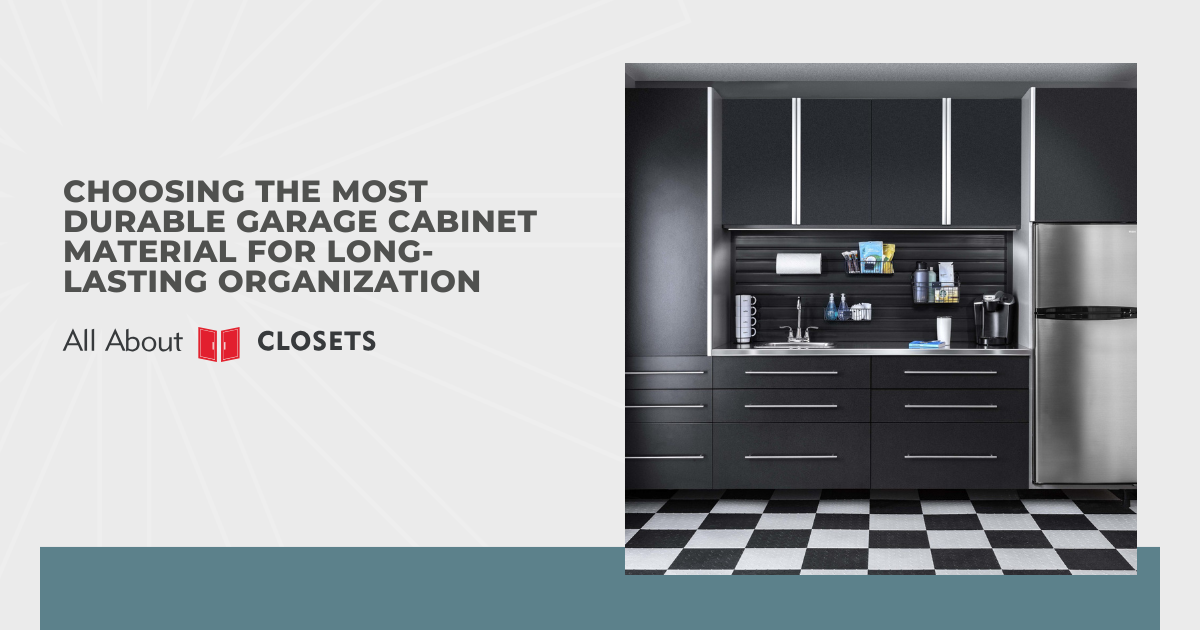Choosing the Most Durable Garage Cabinet Material for Long-Lasting Organization

If you’ve ever opened a warped cabinet door only to have a power drill slide out at your feet, you know the stakes. I’ve seen it happen more than once in real garages with real homeowners who were just trying to keep things tidy. On the surface, all garage cabinets seem like they’re up to the task. But looks don’t mean much when the material inside isn’t built to last.
I’ve been designing efficient garages for years, and I can tell you one thing for sure: what your garage cabinets are made of plays a huge role in how they perform over time. The right cabinet material determines whether your system will last years or just a few seasons.
Here’s what you need to know about the most common garage cabinet materials you’ll encounter:
- Steel cabinets
- Plywood cabinets
- MDF and particleboard cabinets
- Laminate and melamine cabinets
- Hybrid and custom options
- Expert tips for maximizing durability
The material your garage cabinets are made of can either support your goals or work against them. I’ve helped a lot of homeowners rethink their garage systems, and it usually starts with one key decision: what are these cabinets made of, and can they actually stand up to your daily life?
Steel Cabinets
If you’re storing heavy-duty tools, car parts, or anything with sharp edges, steel is usually the first material I recommend.
- Strengths: Steel cabinets can take a beating. They’re resistant to moisture, bugs, dents from everyday use, and can carry serious weight without bowing. In garages that see tough use or varying temperatures, steel holds strong.
- Drawbacks: Steel systems weigh more, cost more, and can show dents if you hit them hard enough. Not everyone needs commercial-grade performance, and it can be overkill in a hobby garage.
Generally, steel is best suited for homeowners who want bulletproof organization, long-term reliability, and don’t mind paying more up front for peace of mind.
Plywood Cabinets
There’s something satisfying about a solid wood cabinet in a garage. Plywood has that classic feel, plus some impressive practical benefits (along with some drawbacks, too):
- Strengths: Plywood holds fasteners extremely well, especially over time. When built correctly, it can support weight without sagging and resists impact better than most composites. It’s also easy to repair or customize.
- Drawbacks: Moisture is plywood’s biggest enemy. If you don’t seal the edges and surfaces, even a humid summer can start to cause warping or delamination. For garages with poor climate control, that’s a red flag.
Plywood works best in finished or temperature-controlled garages where appearance matters just as much as function. It’s a great in-between option for those who want some visual warmth without sacrificing structure.
MDF and Particleboard Cabinets
These are popular for a reason. They’re cheap, easy to manufacture, and look decent at first. But I never recommend them for garages.
- Strengths: MDF and particleboard offer a smooth, uniform surface that takes laminate finishes well. The cost is low, and for interior storage or very light use, they can be serviceable. It’s a great all-around option.
- Drawbacks: Moisture causes them to swell, crack, and fail. Their screw-holding power is weak, and weight loads need to stay minimal. I’ve replaced countless warped or collapsing units made from these materials.
These materials are better suited to closets or indoor offices. In a garage, they’re a short-term fix, not a long-term solution.
Laminate and Melamine Cabinets
Now we’re getting into finishes that are more about how things look than what’s underneath, but they still matter when paired with the right core.
- Strengths: Laminates and melamines come in endless finishes, which makes them perfect for custom designs. They’re easy to wipe down, relatively affordable, and give your garage a clean, polished look.
- Drawbacks: On their own, these materials are fragile. Chips, peeling, and swelling can all occur with moisture or sharp impacts. But as part of a layered system, they add useful protection.
Laminate or melamine work best when used as a finish layer over stronger cores like plywood. It’s a gorgeous finishing touch that makes everything look uniform but shouldn’t be the structural component.
Hybrid and Custom Options
Some of the best garage cabinets I’ve ever installed were hybrid builds. These are the systems that combine the durability of metal with the warmth or customization of wood or laminate finishes.
With this approach, you can still tailor the look and layout. You get the strength of steel where it matters (frames, hinges, shelves) and the design flexibility of other materials. Many of my clients who want the best of all worlds go this route. It costs more, but the long-term reliability makes up for it.
Expert Tips for Maximizing Durability
Beyond picking the right material, the way you set up and maintain your cabinets matters just as much. These are some of the top things I recommend to clients to extend the life of any cabinet system:
- Elevate Cabinets Off the Floor: This is step one for avoiding moisture damage. Even if you live in a dry area, water from car tires, mops, or spills can collect on the floor. Cabinets should be mounted on legs or secured to the wall a few inches up.
- Anchor Securely to Studs or Masonry: Cabinets full of heavy tools or chemicals need more than drywall screws to stay stable. I always anchor into structural studs or masonry, especially in older garages.
- Inspect for Wear and Debris: Dust, grease, and seasonal dirt all take a toll. A quick check every few months keeps everything functioning and helps you catch minor issues before they spread.
- Use Weather-Resistant Materials: If your garage sees big swings in temperature or humidity, don’t rely on bare wood or thin plastic coatings. Go for powder-coated steel or sealed plywood.
- Invest in Quality Hardware: I highly recommend upgrading your hinges and drawer slides. The cabinet box is only part of the system. Weak hinges or cheap glides are often the first to fail, especially under load.
- Avoid Overloading Shelves: Every cabinet has a limit. Spread out heavy items like paint cans or power tools and avoid stacking too high in a single space.
Conclusion
Some garage cabinets look great on day one but buckle under real use. So, I always tell clients to focus on how materials perform over time, not just how they look or what they cost. If your garage is going to stay organized for the long haul, the material has to earn its place. Choose the right option for your needs and it will protect your gear and hold up over time. That’s the kind of investment that makes sense!
